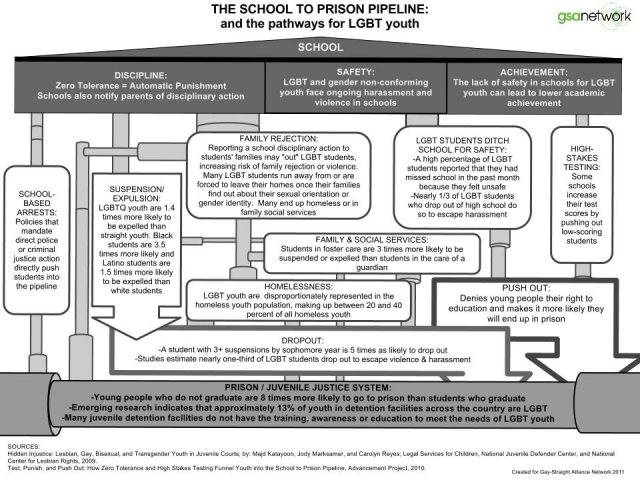
Summary
This is the second section of our Workshop Series: Educational Justice Campaigns. The School-to-Prison Pipeline and GSAs is meant to help students understand what is the school-to-prison pipeline and how is it relevant to queer youth.
Objectives
- Gain a better understanding of educational justice
- Learn about the School-toPrison Pipeline
- Think about who other than LGBTQ youth are being pushed out
Materials Needed: STPP and GSAs Power Point Slides; Paper; Post-its; Pencil/Pens
School-To-Prison Pipeline Intro and School Pushout (0:15)
TRAINER 1 OPENING STATEMENT: Welcome to the School-to-Prison Pipeline (or STPP) and GSAs workshop, the second workshop in the educational justice campaign series. This workshop will help us understand how youth are pushed out, who is being left out of the discussions, and introduce the system that fosters pushout.
TRAINER 2: Before we begin, let’s recap our last workshop. Previously, we discussed what LGBTQ youth pushout is and what it looks like. We also went through a quick activity showcasing how certain students are affected by school pushout and in what ways.
TRAINER 1: Like we did in the last workshop, we’re going to go into school pushout a little more to remind ourselves and to start the next conversation. TRAINER NOTE: Read each question to the group and collect about 3-4 responses.
Discussion Questions:
- What is school pushout?
- How are we as LGBTQ students pushed out of schools?
- Who else is being pushed out?
TRAINER 1: Awesome, so we know that LGBTQ youth are pushed out by dress code policies, antibullying policies like zero tolerance, bathrooms, and unsafe/hostile environments, but what other ways can LGBTQ youth be affected by pushout?
TRAINER 2 SAY: Since we know that LGBTQ youth aren’t the only students being pushed out of schools, can those same students also be LGBTQ and vice versa? If so, what other ways can LGBTQ youth be pushed out? TRAINER NOTE: Take about 2-3 responses. Answers should be something like racism, sexism, xenophobia, ableism, etc.
TRAINER 1 SAY: Exactly, these are all ways LGBTQ youth AND youth who aren’t in our GSA can be affected.
TRAINER 2 SAY: So what does this all mean? Well we are going to watch two quick videos to kind of help us get a grasp it.
TRAINER NOTE: pass out a piece of paper for participants to take notes on. After the videos have ended ask for some responses to the video questions. Take about 2-3 responses
VIDEO QUESTIONS
- Describe the school-to-prison pipeline
- What were some examples of the school-to-prison pipeline given in the videos?
- How are these videos relevant to our GSA?
- Do the examples given in the videos happen in our schools, or in schools nearby?
TRAINER 1 SAY: Exactly. The school-to-prison pipeline is important and relevant to our GSA because some of our students could have been or are those students in the videos. As a social justice club, it is important we make sure that all students have an opportunity to get an education and stay in school.
TRAINER 2 SAY: But before we move on, let’s make sure we’re all on the same page about what the school-to-prison pipeline is. Can I have someone read the definition for the school-to-prison pipeline?
POWERPOINT SLIDE
School-to-Prison Pipeline (STPP): A set of policies or practices used by school districts, like zero tolerance policies, that directly or indirectly push out youth of color, queer youth, queer youth of color, undocumented youth, lower income youth, and differently abled youth, from schools to the prison system.
TRAINER NOTE: Pass out extra or refer back to the Pathways Fact sheet to help with understanding.
TRAINER 1 ASK: What are some other examples of the STPP? How have you seen the STPP play out in our school? TRAINER NOTE: Take about 2-3 responses. Have some examples ready if people get stuck.
Conclusion (0:15)
TRAINER 2 SAY: It’s important to know the ways that a system can be affecting you or the community around you, so we are going to do one last activity to close out this workshop. TRAINER: Get participants into groups of two, and have them sit together and answer the questions below give them 10 minutes to discuss. (Give 1 minute, 2 minute, 5 minute warnings) TRAINER NOTE: Fill in blanks with consensus from the whole group; make sure everyone agrees to these visions and values. Take about 10 minutes to finish this sentence.
POWERPOINT SLIDE
CONCLUSION QUESTIONS
- What is something you learned that you didn’t know before?
- What are your experiences with the STPP?
- How would you dismantle the STPP?
TRAINER 1 SAY: Now that we’ve had our discussion, can I have a volunteer from one of the groups report back what they discussed?
CLOSING STATEMENT: Thank you for sharing. It’s important for GSAs to acknowledge the struggles and realities for all of their members and their communities, and to make sure we can all have access to quality education. In order to make any real change in our schools and in our communities we must work together as a collective and work for the whole rather than the individual.
